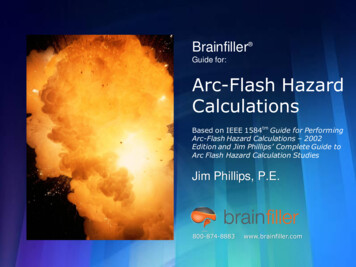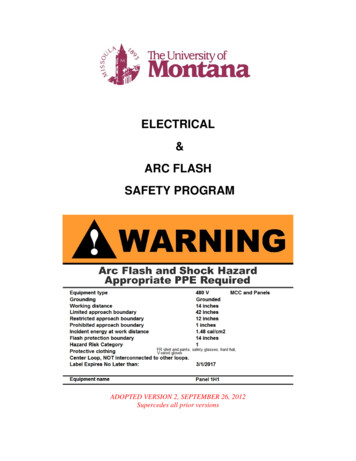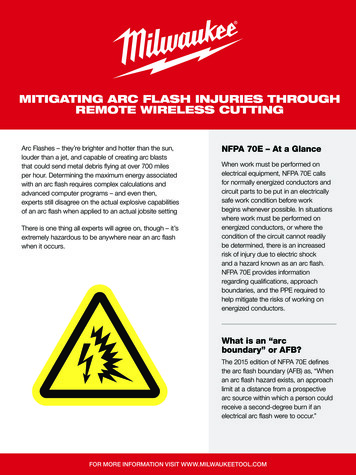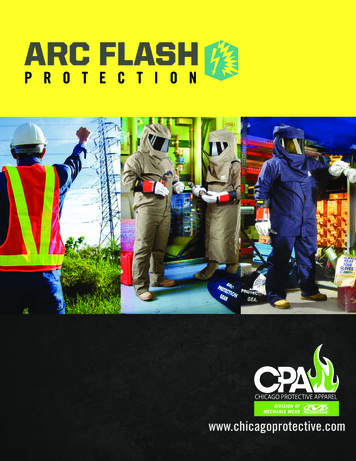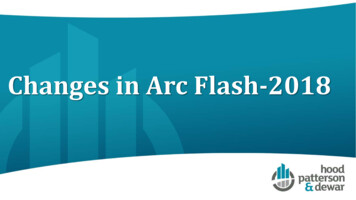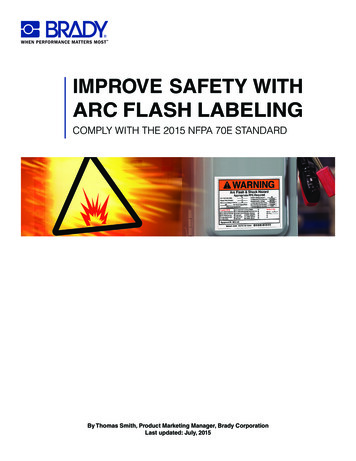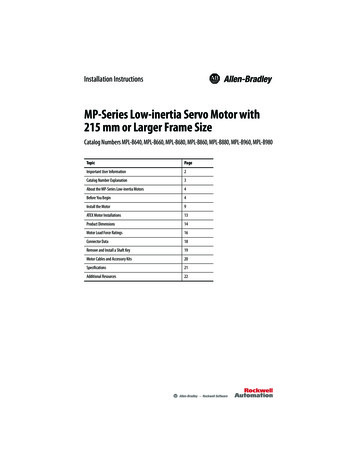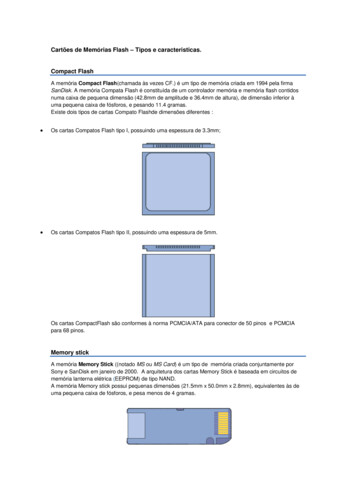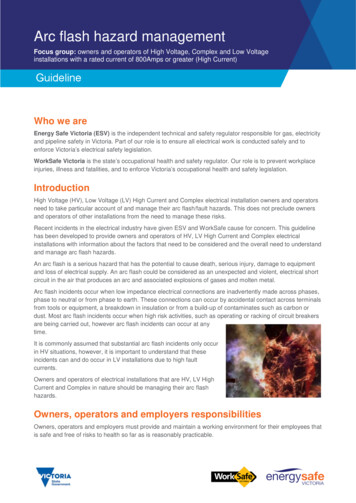
Transcription
Arc flash hazard managementFocus group: owners and operators of High Voltage, Complex and Low Voltageinstallations with a rated current of 800Amps or greater (High Current)Who we areEnergy Safe Victoria (ESV) is the independent technical and safety regulator responsible for gas, electricityand pipeline safety in Victoria. Part of our role is to ensure all electrical work is conducted safely and toenforce Victoria’s electrical safety legislation.WorkSafe Victoria is the state’s occupational health and safety regulator. Our role is to prevent workplaceinjuries, illness and fatalities, and to enforce Victoria’s occupational health and safety legislation.IntroductionHigh Voltage (HV), Low Voltage (LV) High Current and Complex electrical installation owners and operatorsneed to take particular account of and manage their arc flash/fault hazards. This does not preclude ownersand operators of other installations from the need to manage these risks.Recent incidents in the electrical industry have given ESV and WorkSafe cause for concern. This guidelinehas been developed to provide owners and operators of HV, LV High Current and Complex electricalinstallations with information about the factors that need to be considered and the overall need to understandand manage arc flash hazards.An arc flash is a serious hazard that has the potential to cause death, serious injury, damage to equipmentand loss of electrical supply. An arc flash could be considered as an unexpected and violent, electrical shortcircuit in the air that produces an arc and associated explosions of gases and molten metal.Arc flash incidents occur when low impedance electrical connections are inadvertently made across phases,phase to neutral or from phase to earth. These connections can occur by accidental contact across terminalsfrom tools or equipment, a breakdown in insulation or from a build-up of contaminates such as carbon ordust. Most arc flash incidents occur when high risk activities, such as operating or racking of circuit breakersare being carried out, however arc flash incidents can occur at anytime.It is commonly assumed that substantial arc flash incidents only occurin HV situations, however, it is important to understand that theseincidents can and do occur in LV installations due to high faultcurrents.Owners and operators of electrical installations that are HV, LV HighCurrent and Complex in nature should be managing their arc flashhazards.Owners, operators and employers responsibilitiesOwners, operators and employers must provide and maintain a working environment for their employees thatis safe and free of risks to health so far as is reasonably practicable.
Energy Safe VictoriaRegulations 501 and 502 of the Electricity Safety (General) Regulations 2019 outline the duties of ownersand operators of HV and Complex installations. These regulations include, but are not limited to, thefollowing requirements:Owners and operators must ensure that: the electrical installation is safe and maintained and operated safely any person operating the HV or Complex electrical installation has a standard of qualifications, proficiencyand experience that enables that person to safely perform their function any person operating or maintaining the HV or Complex electrical installation has written operating andmaintenance procedures that describe the methods of operation, maintenance, earthing, isolation,energisation and de-energisation of the complex electrical installation any person operating or maintaining any part of the HV or Complex electrical installation is trained,authorised and instructed to perform the work on the complex electrical installation in accordance with theowner or operator's operating and maintenance procedures any person working on or near the installation complies with the provisions of the Blue Book.This does not diminish or underestimate the need to manage potential arc flash hazards for other installationtypes.Under the Occupational Health and Safety Act 2004, employers must provide and maintain a workingenvironment that is safe and free of risks to health, so far as is reasonably practicable.They must also provide and maintain safe systems of work for employees involved in the provision, use,inspection and maintenance of electrical equipment, including all electrical installations, under the employer’smanagement and control.To meet their obligations and provide a safe system of work, employers should identify potential arc flashhazards in the workplace, assess the risks, implement appropriate risk controls and have procedures inplace to review and maintain those controls.Incident energyThe amount of energy that a person is potentially exposed to during an arc flash is termed incident energyand the industry accepted standard for its measurement is generally stated as calories/cm2. The arc energyis the energy in the arc and the incident energy is the energy that reaches an individual or surface at adistance from the arc source during an arc fault. The duration of an arc fault may be short. It is primarilydetermined by the time it takes for circuit protection to operate.Incident energy and personal injury is increased by any or the combination of any of the following factors: higher fault currents longer protection clearing times shorter distances from the arc fault.Arc Flash Hazard Management GuidelinePage 2
Energy Safe VictoriaESV and WorkSafe’s expectationsIdentify the hazardHazards may come from the type of electrical equipment used, how and where it is used, and how it ismaintained. Generally an arc flash hazard is present wherever HV or LV High Current switching occurs.Assess the risk of arc flash – refer to IEEE 1584 or similar standards1.Carry out an Arc Flash/fault study or assessment.If you do not have the competencies available, engage a third party that does have the competency andexperience in this type of work. An accurate arc flash study will quantify the risk and give informationregarding the consequence if exposure occurs.Determine the likelihood of personnel being exposed to an arc flash event.The risk assessment process should include areas where employees are working near (in closeproximity or with high frequency) high-energy switch rooms/gear. Higher risk tasks include live work, liveswitching/racking, fault finding, and installing isolation/earths. Consideration must be given even if thereis no direct interaction with energised boards (i.e. employees in the vicinity) and when automaticoperation of the inherent protection activates.2.Guidance is available in the Australian Energy Council document Electrical Arc Flash Hazard ManagementGuideline, and International Standard IEEE 1584-2018: Guide for Performing Arc-Flash Hazard Calculations.Treat the risk – utilise the hierarchy of controlsEliminate the exposure of personnel to arc flash hazards by only interacting with de-energised and isolatedequipment.Substitute manual operating systems for automated operating systems.Isolate personnel from the hazard by installing physical separation from energised equipment or conductors.Switchboards can be constructed to contain the energy associated with an arc event.Engineering controls Limit incident energy with reduced fault current and/or reduced fault clearance times by adjusting breakerprotection settings. System modifications:–––––––––Arc Flash detection and suppression systemsremote controls and switchingremote racking in /racking out devicesupgrade switchboard form typeupgrade/modify boards to allow for racking with the door closedfixed circuit breakers over rackable breakers for new installation/upgradesinsulated bus barsinstallation design considerations for isolation and maintenance tasksreplacement of fuses which provide faster clearance times.Administrative controls Label all switch rooms, plant and relevant locations to identify incident energy levels and the appropriateactions/precautions that need to be taken Demarcation of arc boundaries Make arc flash registers and diagrams available for employees and contractors Establish effective policy and procedure that reduces exposure, including training and inductionsArc Flash Hazard Management GuidelinePage 3
Energy Safe Victoria Implement of an incident energy and PPE category system as detailed in IEEE 1584 and ENA NENS 09– 2014 or equivalent published standards.Personal Protective Equipment (PPE)Personal Protective Equipment (PPE) is the least effective control and should not be relied upon unlesscombined with other controls. WorkSafe legislation requires employers to adopt higher order controls andonly select PPE when the risk of injury has been reduced, so far as is reasonably practicable. PPE may thenbe used to treat the residual risk. This is because PPE does not prevent injury but may reduce severity.To select the appropriate PPE for an electrical arc hazard environment, the following steps need to beundertaken.1.2.3.4.5.6.Understand the hazard.Identify assets or asset groups with arc flash/fault hazard potential.Quantify the hazard – calculate the incident energy in each relevant location.Assess the risk – using your organisation risk management framework.Reduce the risk, so far as is reasonably practicable, using the hierarchy of controls.Select the appropriate PPE if a residual risk of injury is present i.e. incident energy of greater than1.2 calories/cm2 remains.The figure above is an example of a PPE and category system, provided courtesy of the Australian Energy Council.UNDERSTAND THE RISKSCOMMUNICATE AND EDUCATEArc Flash Hazard Management GuidelinePage 4
Energy Safe VictoriaFurther informationFor more information regarding Arc Flash Hazard Management, contact the WorkSafe Victoria AdvisoryService on 1800 136 089 or visit worksafe.vic.gov.auFor information on electricity safety legislation, contact Energy Safe Victoria on 093 9203 9700 orvisit esv.vic.gov.auAustralian PublicationsAEC Electrical Arc Flash Hazard Management Guideline March 2019ENA NENS 09 - National guide to the selection, use and maintenance of PPE for electrical arc hazardsInternational PublicationsIEEE 1584-2018 Guide to performing Arc Flash Hazard CalculationsNFPA 70E- Standard for Electrical Safety in the Workplace 2018ReferencesVictorian Occupational Health and Safety Act 2004Electricity Safety Act 1998Occupational Health and Safety Regulations 2017Electricity Safety (Installation) Regulations 2009Electricity Safety (General) Regulations 2019AS/NZS 3000 Wiring RulesAS/NZS 4836 Safe working on or near low-voltage electrical installations and equipmentCode of practice on electrical safety for work on or near high voltage electrical apparatus (the Blue Book)NEC Electrical Arc Flash Hazard Management Guideline March 2019ENA NENS 09 - National guide to the selection, use and maintenance of PPE for electrical arc hazardsIEEE 1584-2018 Guide to performing Arc Flash Hazard CalculationsNFPA 70E - Standard for Electrical Safety in the Workplace 2018Document informationFor information regarding this document please contact:Electrical Installation SafetyEnergy Safe VictoriaLevel 1, Building 4 Brandon Business ParkGlen Waverley VIC 3150Phone: (03) 9271 5414WorkSafe Victoria’s Advisory ServicePhone: 1800 136 089Note: This guidance material has been prepared using the best information available to Energy Safe Victoria and WorkSafe, and shouldbe used for general use only. Any information about legislative obligations or responsibilities included in this material is only applicableto the circumstances described in the material. You should always check the legislation referred to in this material and make your ownjudgement about what action you may need to take to ensure you have complied with the law. Accordingly, Energy Safe Victoria and/orArc Flash Hazard Management GuidelinePage 5
Energy Safe VictoriaWorkSafe cannot be held responsible and extends no warranties as to the suitability of the information for your specific circumstances;or actions taken by third parties as a result of information contained in the guidance material.Arc Flash Hazard Management GuidelinePage 6
Code of practice on electrical safety for work on or near high voltage electrical apparatus (the Blue Book) NEC Electrical Arc Flash Hazard Management Guideline March 2019 . ENA NENS 09 - National guide to the selection, use and maintenance of PPE for electrical arc hazards . IEEE 1584-2018 Guide to performing Arc Flash Hazard Calculations
